12 Ways To Add Flavor To Brisket
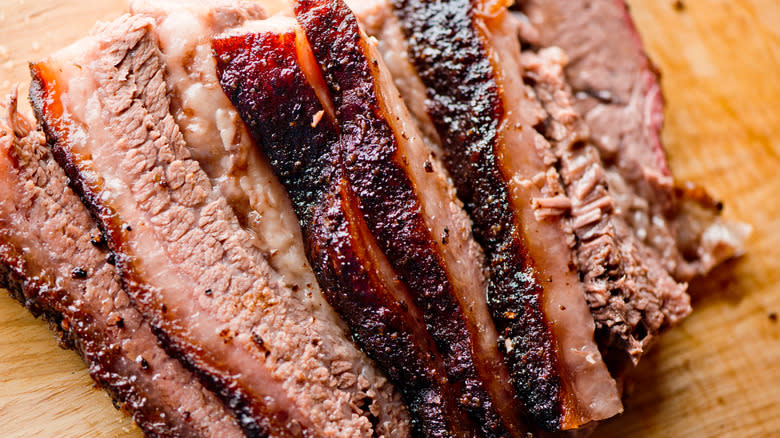
Whether it's the onset of sweater weather, the excitement of football, or the arrival of Judaism's High Holidays, there comes a time every year when it is officially brisket season.
Cooking this cut of beef is a project ideal for crisp fall weekends when you've got a few hours to spare, as the meat needs ample time to become tender and succulent. Going low and slow on a smoker will give you an incredible crust and a juicy, beefy interior that Texas barbecue purists say should be enjoyed on its own; no sauce allowed. As the centerpiece of a holiday meal, you can't beat a brisket braised in a flavorful broth. Or you can go full deli style, corning — or curing — your brisket for up to a week in a salt brine infused with whole spices, then serving it piled high on rye.
No matter how you choose to cook brisket, all that time cooking means you've got ample opportunities to infuse your brisket with serious flavor. And if it's not done right? Well, you might just wind up with tough, dry, and flavorless meat instead of the juicy slices you've seen on barbecue competition TV shows. Don't risk bland brisket. Instead, choose flavor — because incredible brisket is well worth the effort.
Read more: Your Guide To The Different Cuts Of Steak
Choose The Right Cut Of Brisket For Your Cooking Style
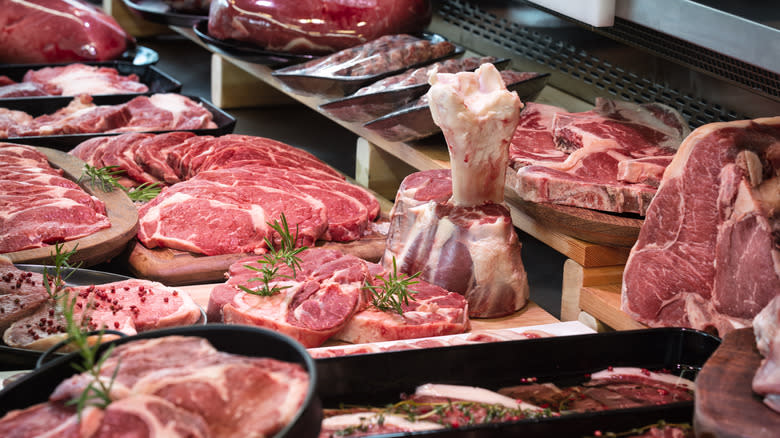
There are eight primal cuts of beef: chuck, rib, loin, round, flank, short plate, brisket, and shank. Brisket is made up of a steer's pectoral, or chest, muscles. They're muscles that are used frequently, which explains why this cut is particularly lean.
A full brisket is actually two overlapping muscles, colloquially known as the flat and the point. The flat is the square or rectangular end of the brisket, more uniform in thickness and ideal for braising or making corned beef or pastrami. On the other hand, the point tapers toward one end and has more fat. It is the cut of choice for smoking, particularly because this is where burnt ends come from. The two portions are occasionally sold together; however, they're most often separated for cooking because they benefit from such different cooking methods.
When sourcing your perfect brisket, a butcher is your best bet. Many briskets sold at grocery stores are previously frozen (you can tell from all the blood and liquid sloshing around in the Cryovac packaging), and the defrosting process means the brisket has lost some of the very little moisture it had. A butcher, on the other hand, can point you toward the correct cut for your cooking method. You might spend a little more, but you'll get higher-quality meat and a true, beefy flavor that grocery store options can't rival.
Brine, Rub, Or Marinate
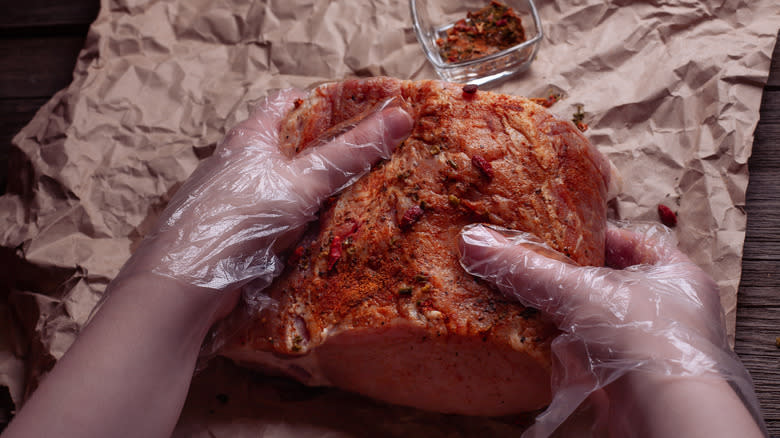
Now that you have your brisket in hand, it's time to add some pre-cooking flavor. There are three ways to add flavor to meat before cooking: brine, a rub, or a marinade.
A brine is an opportunity to add moisture to a piece of meat. Brines consist of salt and water, occasionally with other spices added to infuse additional flavor. Remember, salt does more than just make things salty — the right amount of salt will make food taste more like itself, in this case, making your brisket taste like, well, meat.
A rub adds flavor to the outside of the meat. Dried herbs and spices are combined and rubbed on the outside of the meat. In the case of smoked brisket, the rub is what gives flavor to the bark or crust. Your rub could simply be salt and pepper or could include additional flavorings (think paprika, cayenne, or brown sugar).
A marinade does a little bit of both. Adding acid — like citrus juice or vinegar — helps tenderize meat, while including salt and seasonings (plus things like vegetables, fresh herbs, or fruit) adds flavor and moisture.
The crucial ingredient in any of these options is time, a theme when it comes to cooking brisket. Allowing the seasoning to infuse for hours, or even overnight, ensures it has penetrated into the meat, so the center of the brisket is just as delicious as the edges.
When Smoking, Keep The Seasoning Simple
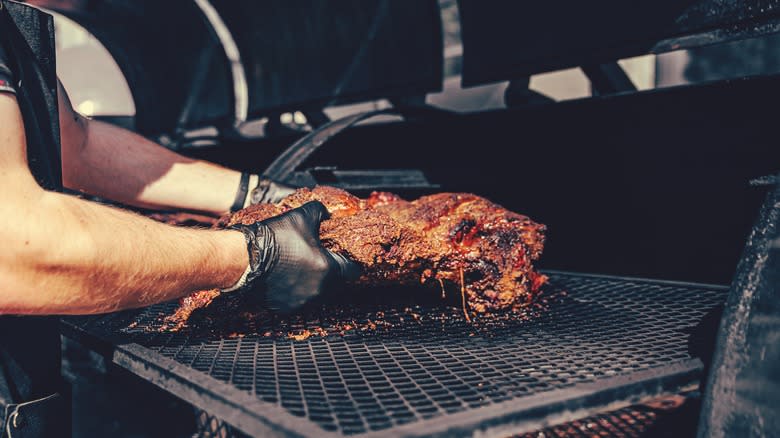
No one does smoked brisket better than Aaron Franklin of Franklin Barbecue, who stays true to Texas-style barbecue and insists on keeping his rub simple to let the meat really shine. Franklin uses only salt and pepper, with a little bit of mustard, to help the seasoning adhere to the meat (though the long, slow cooking process means you won't taste the mustard in the final product). Franklin even specifies how coarse to grind the pepper, identifying a 16-mesh "café grind" as the ideal coarseness for maximum adhesion and flavor.
To get the most out of every bite of brisket, cover your entire brisket in a mixture that is equal parts salt and pepper. Then, go back and add more salt to the fattier sections and more pepper to the leaner sections to amp the flavor up even more.
If your perfect bite combines tender meat with a crusty, flavorful bark like you'd find on Kansas City-style brisket, slather it in a slightly more complex rub. Combine brown sugar, pepper flakes, garlic powder, and cumin with your salt and pepper, and add a generous coating to the meat before smoking.
Choose Wood Wisely For Flavorful Smoke
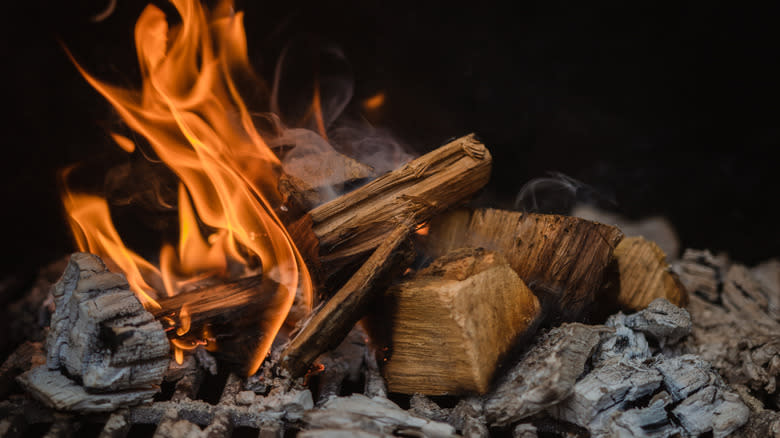
The wood you choose when you barbecue does more than create heat and smoke. The long, low-and-slow smoking process required to cook brisket gives plenty of time for the smoke to infiltrate the meat, and the smoke's flavor profile will become part of your finished product.
Hickory will give your meat a subtle, savory, nutty flavor, especially if you keep the seasoning incredibly simple. Pecan, on the other hand, is a little sweeter, which would be enhanced by a rub, including some brown sugar. Apple and maple wood are sweet and mild, and both are fantastic choices if you're still getting the hang of using smoke as both a tool and an ingredient and don't want the smoke to overpower your meat. Mesquite wood is the go-to choice for Texas barbecue. This wood is earthy and rich, and using it at home will conjure up memories of a visit to your favorite pitmaster.
To mellow out any more flavorful wood, mix in oak to dial back stronger sweet, savory, or earthy notes. Choose the right cut of wood (chunks, logs, chips, or pellets) to work with your smoker, and stay away from the charcoal bricks. Charcoal does provide even heat, but it doesn't bring flavor to the party the way wood can.
Spritz Your Brisket While It Smokes
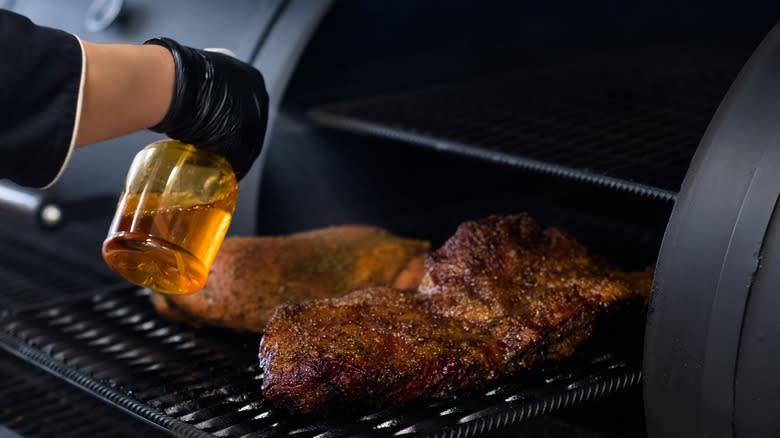
It takes a long time for the connective tissue in brisket to break down and produce tender meat, and all that time means the meat can start to dry out before it's properly cooked. To prevent the meat from drying and to get a chance at a little extra flavor, take some time to spritz your brisket throughout the cooking process.
A spritz will add moisture, add sugar to increase caramelization on the crust, and also help create that coveted pink smoke ring since moisture attracts smoke to the meat. Common brisket spritzes include apple cider vinegar, apple juice or cider, beer, and beef broth.
Just be sure to wait until the rub has adhered to the meat and it has begun to develop a crust before spritzing, or else it can wash off any seasoning you applied before you started cooking. Spritz sparingly to keep the crust from getting soggy, lightly coating the meat every hour or so. And work quickly! Opening the smoker lets out smoke and heat, so a speedy spritz will let the fire and meat get back to work.
Turn A Brisket Point Into Burnt Ends
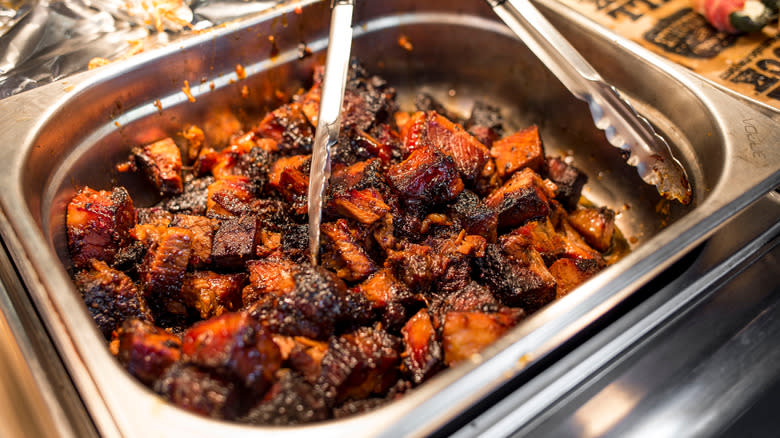
Burnt ends started as the cast-off trimmings of smoked brisket, tough pieces that used to be discarded as the more succulent meat from the flat was sliced and served. Pitmasters would chop up these deeply caramelized (well, burnt) pieces, then put them out for customers to snack on as they waited for their orders. Eventually, everyone realized that the trimmings were actually in high demand — and shouldn't be handed out as samples.
To make burnt ends at home, James Beard finalist Chef Matt Horn uses a flavor-packed rub that includes brown sugar and cayenne pepper. He smokes the brisket for a total of six hours (the final two wrapped in foil) to give the meat time to develop a flavorful crust while also allowing the connective tissue to break down. He then cubes and sauces the meat, returning it to the smoker at a higher heat for a few more hours to caramelize every bite. Talk about flavor.
Top Barbecue Brisket With A Flavorful Sauce
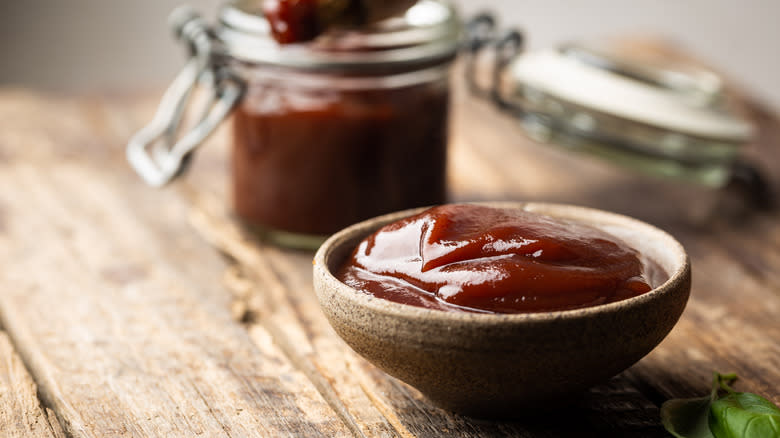
An epic sauce will hide any multitude of barbecue mistakes, but it will make well-crafted barbecue really shine. With so many types of sauce to choose from, the resulting flavor becomes something of a choose-your-own-adventure story.
Most Texas barbecue aficionados will say perfect brisket doesn't need sauce, and that salt, pepper, and lots of time in the smoker are all it takes for amazing flavor. A Worcestershire-based sauce (often including beef drippings) will enhance that beefy flavor without covering it up, while barbacoa-inspired sauces from southern Texas are a mouthwatering finish to seriously good brisket.
In Kansas City, on the other hand, brisket burnt ends are served with the region's iconic tomato-based sauce. Brown sugar and spices, from paprika to pepper, give the bark its classic caramelized flavor.
When you're cooking brisket at home — and aren't trying to be authentic to a particular region — get a little chef-y with your sauce. Pomegranate molasses barbecue sauce is sweet and tangy, incorporating flavors you might find in braised brisket, as well. Mustard (like in South Carolina barbecue sauce) may be more traditionally served with pork, but that unmistakable bite brings to mind a towering corned beef sandwich, which is definitely not a bad thing.
Add Punchy Flavors To Your Braising Liquid
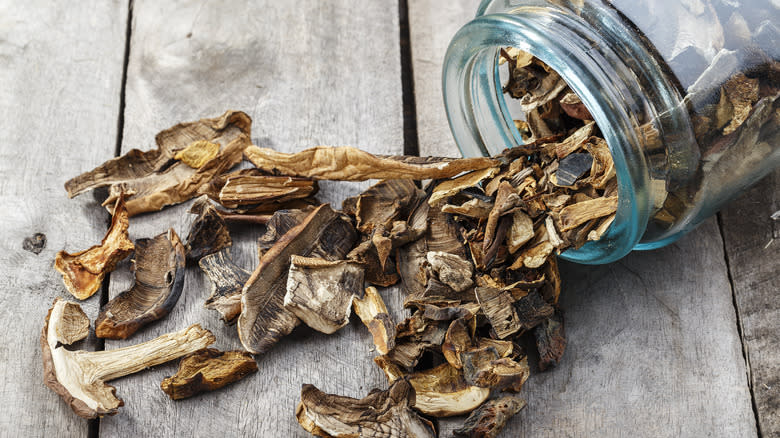
Brisket loves to be cooked low and slow, and braising is a hands-off way to create a totally phenomenal meal. Connective tissue breaks down, fat melts, and flavor gets infused into every bite — as long as you choose to braise your brisket in a liquid that brings extra flavor to the party.
Broth and stock are go-to choices for braising (broth is made with bones, stock is made with meat plus herbs or vegetables), as are wine and beer. With a beefy cut like brisket, you'll want a jammy red wine or the acidity of a lager — don't worry, the alcohol will all burn off in the cooking process. You can also get similar flavors from pomegranate or cranberry juice.
Build flavor from the very beginning. Give your aromatics time to brown and caramelize for extra depth. Stir in tomato paste for extra sweetness and acidity, then deglaze with your liquid of choice. Amplify flavors even more by adding miso, Worcestershire sauce, fish sauce, or dried porcini mushrooms. Save all that cooking liquid when your brisket is done to create a phenomenal sauce for the final product.
Reheat Braised Brisket In The Cooking Liquid
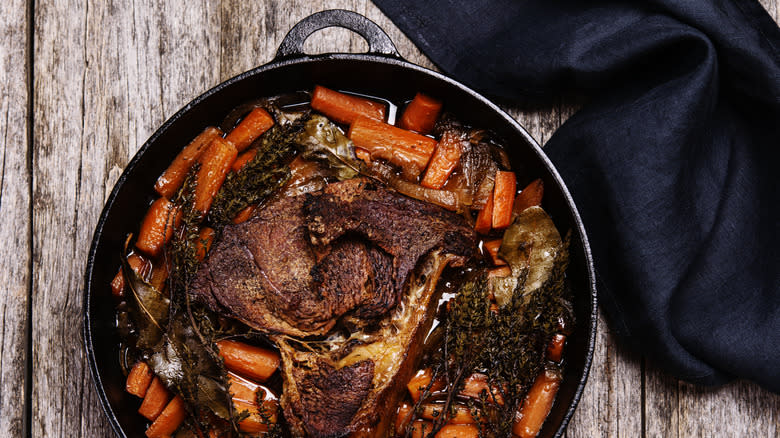
The practice of resting meat before you slice it is for more than just grilled steak and roasted chicken. If you plan to slice your braised brisket before serving it, allowing the meat to rest and cool will help you get uniform slices instead of a pile of shredded meat.
While the cooked brisket is cooling, you'll have a chance to cook down (and dress up) the braising liquid so it becomes a savory sauce to serve alongside the meat. Then, return the sliced brisket to the sauce and warm the meat through before plating. This keeps the brisket from drying out and amplifies the braising liquid's flavor.
This extra step is also a great trick if you're having company over for dinner — which you should, as a braised brisket is definitely a celebratory meal. Braise the meat the day before your dinner party, then slice it while you finish the sauce. Allow the sauce to cool, and return the sliced meat to the pan, ready to head to the fridge overnight. The next day, all you'll have to do is warm the meat and sauce together while you prepare the sides. When treated properly, braised brisket really does taste better the second day, anyway.
Corn Your Brisket
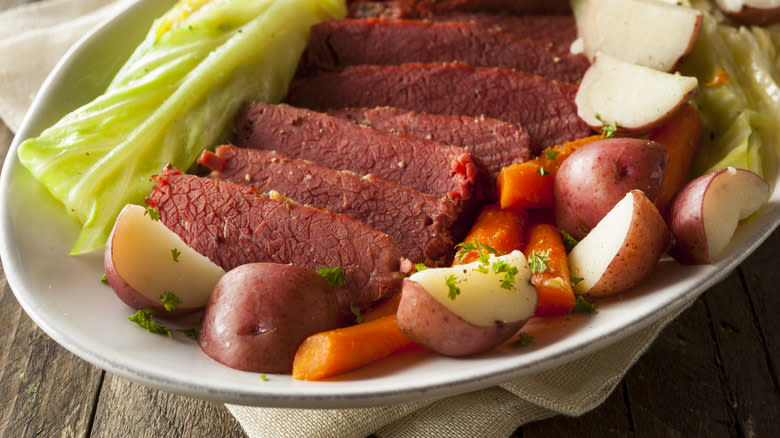
Cooking brisket takes time and patience, and making your own corned beef takes the most time. Beef brisket is submerged in a brine made of water, sugar, spices, and curing salt to cure — or pickle — the meat, and it's left there for about 6 days. Curing salt is key, as this type of salt includes sodium nitrite or sodium nitrate (or a combination of the two) to preserve the meat during the brining process, preventing the meat from turning grey and giving corned beef its distinct pinkish hue. You can corn brisket with salt that does not contain preservatives; just know your beef will be more gray than pink. The result is meat full of tangy, spiced flavor that is ready to be cooked.
But how? Traditional recipes boil or simmer the brisket after it has been corned, but you can also cook it in a crock pot or put it in a roasting pan, wrap it tightly in foil, and steam it in the oven. No matter what cooking method you choose, be sure to include aromatics like carrots, onions, and more of the same spices you had in your brine to enhance the flavor.
Make A Brisket Sandwich
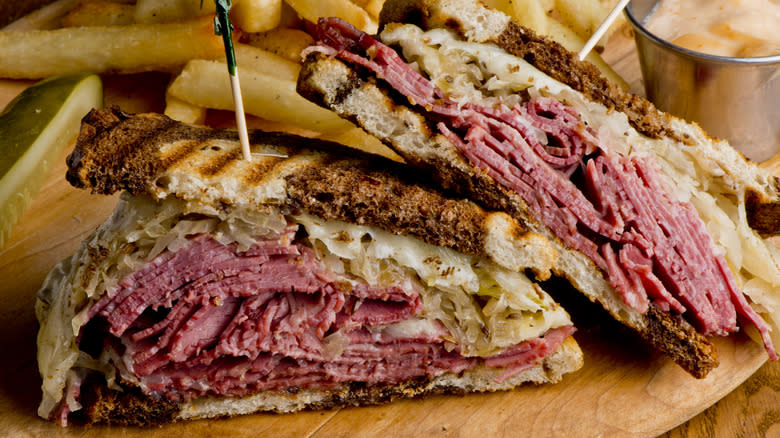
No matter how you cook it, building a serious sandwich is a great way to add flavor to leftover brisket (or turn subpar brisket into the star of the show). The perfect combination of bread, toppings, and sauces will take brisket to the next level.
Classic Reubens and corned beef sandwiches are deli classics for a reason. Crusty, seedy rye bread echoes the flavors used in the curing process, sauerkraut mirrors braised cabbage, and what could be wrong with spicy mustard or Russian dressing? If your brisket was smoked, pile up barbecued brisket on a soft bun, like brioche or potato bread, and add homemade barbecue sauce. Other toppings, like coleslaw and pickles, can help cut through the sweetness of the sauce while the soft bun soaks up all the juices.
Or, transform corned beef into Reuben egg rolls for a playful take on a Reuben. Roll corned beef, swiss cheese, and sauerkraut into egg roll wrappers, deep fry, and serve with Russian dressing for dipping. You've done the hard work of making brisket, so it's time to reap all the rewards.
Infuse Your Brisket With Korean Flavor
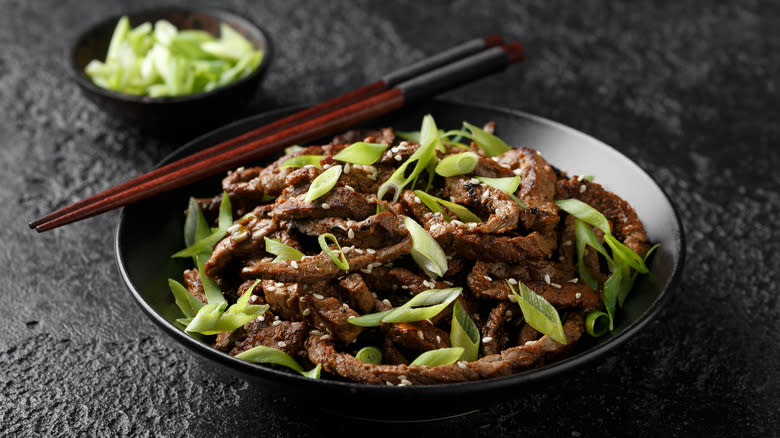
Bulgogi is an incredibly popular Korean dish made of thinly sliced beef in a flavorful marinade. Often, bulgogi is made with sliced ribeye as the marbling keeps the meat tender and succulent, but let's face it: ribeye is pricey. Because the meat spends time marinating before it is cooked, you can swap in brisket for a more affordable option.
Use a brisket point, which is more tender and has a higher fat content than the flat. Chill the meat in the freezer so it is easier to slice, then assemble a bulgogi marinade using soy sauce, sugar, sesame oil, onion and garlic powder, and gochugaru, or Korean red pepper flakes. Don't forget pear or pineapple juice to help the meat break down and add sweetness. Let the sliced brisket marinate for an hour, then grill or cook in a hot cast iron pan for the perfect combination of succulent beef and caramelized edges.
Read the original article on Tasting Table.

